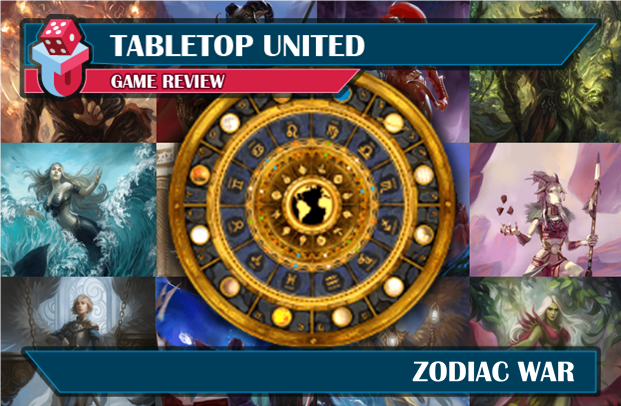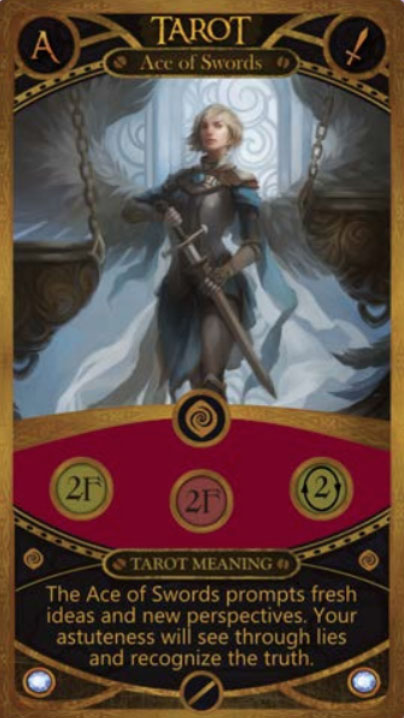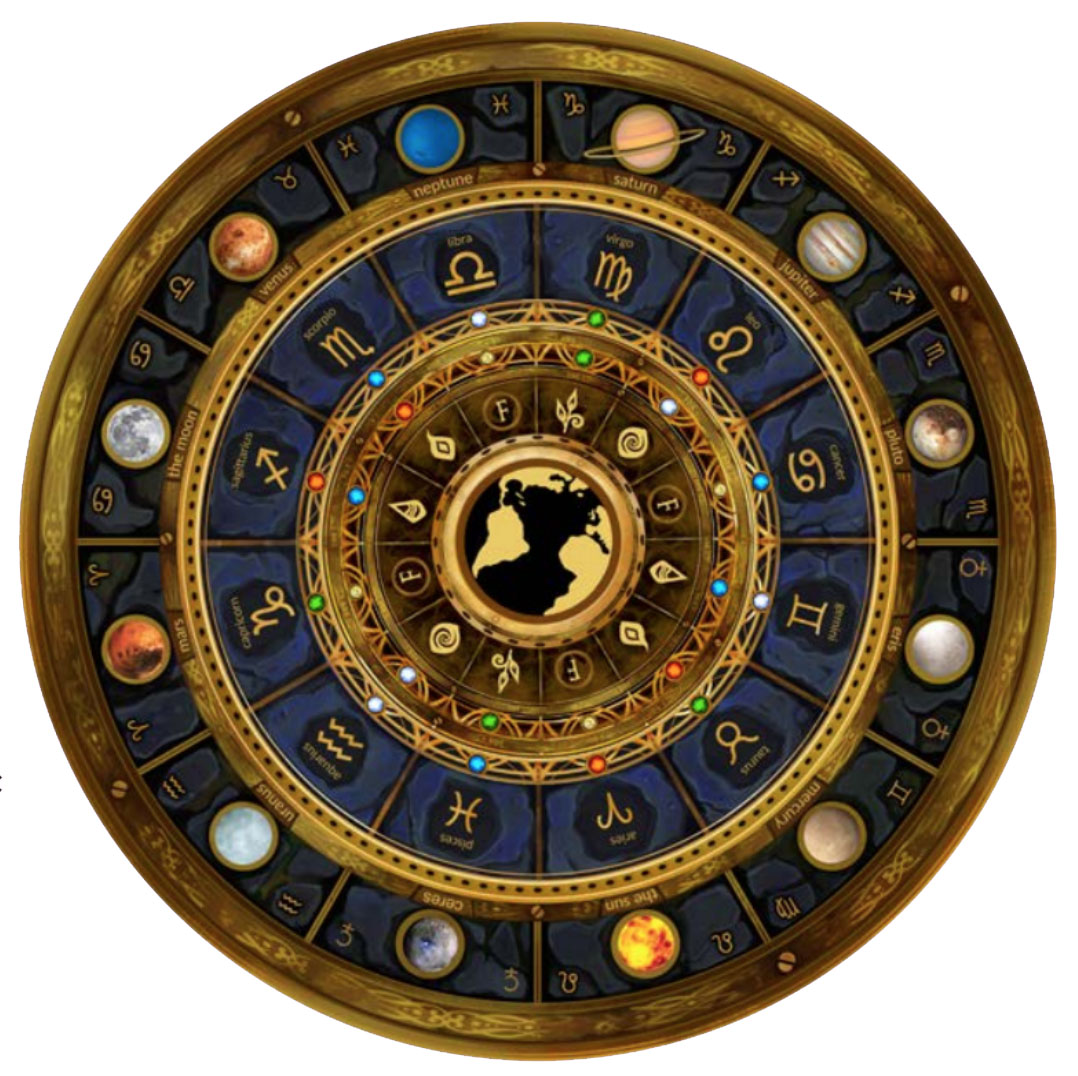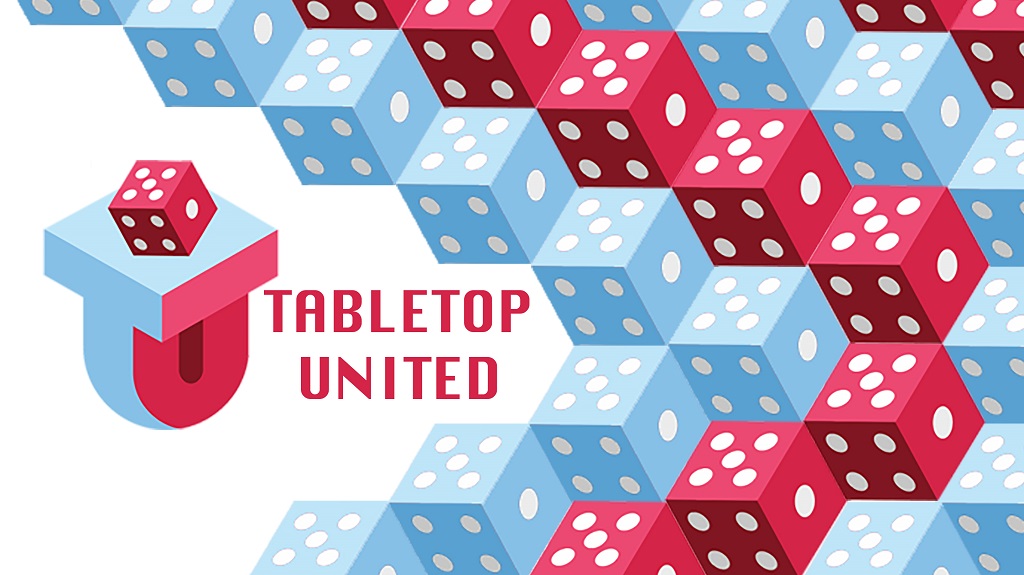
Designer: Paul Starr
Artist: Katerina Poliakova & Conor Smith
Publisher: Self-Published
Year Published: 2021
No. of Players: 2-4
Ages: 14+
Playing Time: 60-90 Minutes
Main Mechanism / Theme: Puzzle / Astrology
Zodiac War is a beautifully illustrated game with excellent table presence that perfectly marries its astrological theme with an incredibly satisfying rotating board mechanism.
Find more info on BoardGameGeek.com & Kickstarter
Overview:
Zodiac War is a rotating board game based on astrological themes. The game draws on authentic themes such as personalities of the signs, aligning planets and elements, and drawing on powers of tarot cards. The game is for 2-4 players, takes about 60-90 minutes to play, and features a fully functional tarot deck of cards!
Setup:
Players will select one of the 12 zodiac signs and take its corresponding player mat. These player mats are large, beautifully illustrated, and feature much of the information players will need to know about how to play (e.g., special powers, phases of play, iconography, affiliated planet and element sign, etc.). Additionally, each player is dealt a hand of 5 tarot cards, which will be covered in greater detail below.

Gameplay:
Every turn starts out by drawing a zodiac card that features a horoscope as well as directions for how to manipulate the element and planet rings. A bonus reward is also provided in the event that the planet ring is rotated greater than or equal to a pre-determined number of spaces. This element of the game incorporates a bit of luck that keeps the board state ever changing. As such, it is not always possible to plan ahead of this step on your turns. Additional bonuses and rewards are provided on these zodiac cards with some cards permitting you to take resources from other players. This element of player interaction can, at times, further impacts a player's ability to plan ahead of their turn. Finally, each zodiac card has a final bonus or penalty that affects those with a zodiac symbol matching one of the 4 printed at the bottom of the card.
Next, players will select up to 4 of their 5 cards (i.e. 1 major arcana and 3 minor arcana) to play to the table. These cards are played in a row, purposefully arranged in a sequence based on the desired effect. Each card is resolved, left to right. In the example provided below, the Ace of Swords would provide one of the following effects based on its position in the row: left-most spot = gain 2 faith, middle spot = lose 2 faith, right-most spot = rotate the element or planet ring 2 spaces. Each card features a zodiac sign or element symbol in the center that grants the active player an extra tarot card if the symbol matches one of those on their player mat. In addition to these effects, cards featuring an Ace or 2 may be played at any point (even out of turn) in order to interrupt or nullify the effects of another player's card. This can help prevent a specific ring from being rotated before your turn or help to limit your opponent's ability to gain more faith tokens needed to purchase crystals (i.e. the objective of the game). Major Arcana cards are less common in the game but offer unique abilities that can potentially ramp up player interaction (e.g., looking at an opponent's hand and stealing one of their cards).

Through the effects of these tarot cards, players aim to align their planet, zodiac sign and element symbol (or wild "F") in an effort to gain as much faith as possible:
- Aligning the player's element symbol (or wild "F") with their zodiac sign = 2 Faith.
- Aligning the player's planet with their zodiac sign = 4 Faith.
- Aligning the wild "F" element symbol with a player's zodiac sign AND planet = 6 Faith.
- Aligning the player's exact element symbol with their zodiac sign AND planet = 8 Faith.
- If a player has aligned all 3 components (i.e. perfect alignment) and has at least 10 faith, they may choose to purchase a crystal rather than collecting faith. A player may purchase any number of crystals for 10 faith each.
Before ending their turn, a player may replenish their hand of tarot cards by purchasing new cards from the facedown deck at a cost of 2 faith per card. Players may have a maximum of 7 cards in their hand at one time. This manner of play continues until the round in which a player has successfully purchased their 3rd crystal, triggering the end of the game. All players who have yet to take a turn in this round will finish the round. In the event that more than 1 player has purchased 3 crystals in the last round, the following tie-breakers take effect (in this order):
- The player with the most faith tokens remaining in their supply wins.
- The player with the most tarot cards is the winner.
Theme, Illustration, and Graphic Design
The theme drives a lot of the visual elements in this game and it totally works! The illustrations on player mats and tarot cards are gorgeous. The graphic design has some elements that I found problematic; namely, the limited contrast provided to some of the iconography (e.g., black symbols on relatively dark, colored circles). Additionally, the flavor text provided on cards includes a combination of horoscopes and fun facts about relative planets. However, there was no clear distinction in formatting between the flavor text and the text, which actually relates to gameplay. In fact, these bonus effects were found nestled between the horoscope and planetary information on the card. It should be noted that the copy of Zodiac War reviewed was still a prototype; as such, some elements may be altered before final production. Because the deck of tarot cards are meant to serve as a fully functional tarot deck, I can see why these choices might have been made. However, I would much prefer to see a cleaner layout that puts the gameplay front and center, presenting the informative text in a manner that doesn't detract from the cards' primary function.

Final Thoughts:
The strongest element of the gameplay, in my opinion, was the card play. Utilizing multi-use cards that change based on their position in the row creates an interesting puzzle each turn. At times, I was forced to play cards to specific spots because I did not want to suffer the penalty associated with alternative positions. This was reminiscent of the multi-card, action-selection mechanism featured in Stefan Feld's La Isla. At 2-players, I found the manipulation of the rings to be fairly manageable with gameplay lasting approximately 45 minutes. Some elements of player interaction within the game; namely, those tarot cards that allow players to impact the resources of others, may not gel with players who do not enjoy "take that" in games. Furthermore, the ever-changing board state may lead to longer games for those players who are prone to analysis paralysis. However, as I mentioned before, the card play does provide some interesting decisions that don't always necessarily involve consideration for the rotating of the game board as you can often play cards to simply gain more faith or tarot cards. At first glance, this game looks like it may be heavier than it is. However, the decisions available are fairly straightforward and the winning objective is simple enough to explain in seconds. I would not necessarily categorize this game as a filler but I wouldn't call it a mid-weight game either. This game is both educational and accessible to gamers of all experience levels. Zodiac War is a beautifully illustrated game with excellent table presence that perfectly marries its astrological theme with an incredibly satisfying rotating board mechanism. I would personally recommend this game to lovers of astrology, tarot card reading, and/or abstract/puzzle games.

